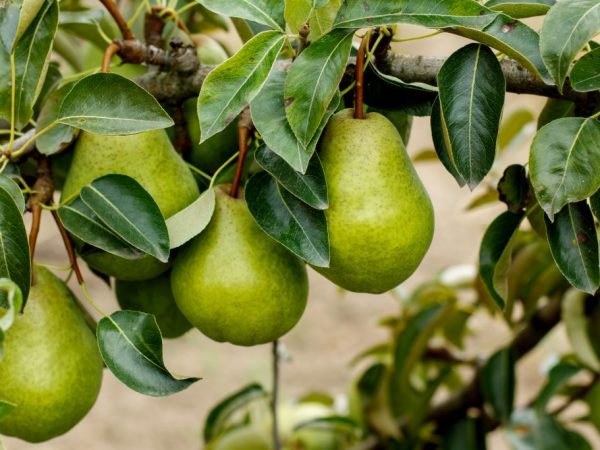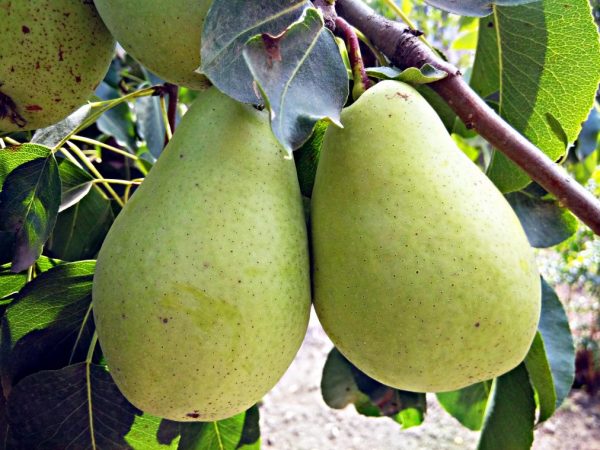Pear variety Just Maria
Pear Just Maria is considered one of the best fruit varieties. Gardeners are advised to purchase seedlings of this variety. We will consider a detailed description of the variety in the article.

Pear variety Just Maria
Characteristics of the variety
The self-fertile pear bred by the Belarusians Just Maria was the result of crossed hybrids, one of which is the 6 / 89-100 form, and the other, little known among Russian gardeners, Butter Ro.
Description of pears Just Maria: a late-ripening variety, because this tree begins to bear fruit only in October, and the period for full ripening of fruits ends only in the last days of autumn. Differs in high productivity regardless of climatic conditions, withstands frosts down to -35 ° C -38 ° C. Even after freezing, pear trees retain their ability to bear fruit, quickly revive and bring a good harvest.
Appearance
Characteristics of the pear variety Just Maria:
- the average weight of large fruits reaches 160-180g, the maximum possible weight may exceed 200g;
- The color of the fruit is green-yellow with a slight pink tint, the shape is classic, with an even smooth skin, the stalk is short, thickened and slightly curved;
- the fruit pulp is colored in a creamy shade, it has medium density and oiliness, a sweet and juicy aftertaste with a slight sour aftertaste.
Benefits
Advantages of the Prosto Maria pear variety:
- good taste characteristics prevailing over other pear varieties such as Bere Box;
- trees begin to bear fruit in a relatively short period after planting - in the 3rd or 4th year;
- ripening even in cold climatic conditions and maintaining its vital activity at low temperatures;
- increased resistance of the pear variety to most diseases characteristic of fruit trees.
disadvantages
Description of the disadvantages of the Prosto Maria pear variety:
- summer residents of the Moscow region and other Russian regions note that for good yields, it is imperative to plant next to trees in the process of growing and caring for trees that attract pollinating insects for the purpose of natural pollination.
Preparing for landing
The time for planting is late autumn, when foxes fall on the plants and the first cold begins.
Before planting in the soil, they are soaked in water for 5-7 hours. For a seedling, a hole is prepared in the ground from soil and peat with a depth of 1.0-1.5 m, making it conical. The root shoots of the tree are distributed over the entire earthen cone and fill the hole with fertile soil, lightly tamping.
A suitable place is the southern part of the personal plot. But it can bear fruit even in the shade.
A peg is driven in near the tree, which will become a support for the plant. It is to him that the seedling is tied with fabric strips. Immediately after planting, the pear plant is watered, and when the soil has absorbed all the liquid, the earth around it is loosened.
Growing care

Take good care of your plant
For this pear variety, full-fledged care is important so that the plant does not get sick and does not stop its growth and development rates.
For young seedlings, it is important to create favorable conditions:
- ensure the supply of oxygen to the roots, loosening and weeding with due regularity,
- according to the established schedule, add nutrient complexes, which include potassium, phosphorus and nitrogen, and when the fruits are formed, add a urea solution with a concentration of 0.4% to the soil,
- create protection against rodents that infect trees in the fall, for which wrap them with compacted paper,
- prepare the tree for winter frosts by creating an elevation from the soil and covering the soil with foliage around the trunk.
Watering
The tree needs constant watering, especially during dry summers. Regularity and abundance of watering are the main conditions for care.
This is done not only immediately after planting the plant in the garden, but also throughout the season with a frequency of 4-5 times. The water consumption rate for one pear tree leaves about 3 ten-liter buckets. After the watering procedure, the soil is loosened, providing oxygen access to the root system.
Breeding rules
Reproduction of the pear variety Just Maria is carried out by cuttings, through layering and through grafting.
Propagation by cuttings
It is necessary to take a green stalk from a ripe pear tree that has leaves and place it in a warm environment where the temperature reaches 20 ° -25 °. Under these conditions, the offshoot will develop roots in a short period of time.
You can maintain the required degree with a film.
During the hot period, the cutting is sprayed 5-6 times a day. Spraying frequency is reduced in cloudy weather up to 2-3 times.
To accelerate the appearance of roots in cuttings allows the treatment of cuttings with growth stimulants.
In the greenhouse, the cuttings are laid out so that the shoots are above the soil level.
Reproduction by layering
This method is considered the easiest. An important condition is to choose the right shoots from an adult pear. Initially, the soil is prepared, where it will be necessary to root the shoots, saturating it with oxygen and moistening abundantly.
This breeding method has a number of features:
- practically no harm is done to the parent tree,
- the shoot is covered with earth, leaving only its top,
- cut off the layers a year before the formation of the roots, choosing the most developed,
- when the root system appears in the proper state, the layers are detached from the parent.
Graft propagation
This is the most difficult technology and time-consuming method, in which a branch is cut off a tree and grafted onto another plant. They resort to this method before the arrival of sap flow or after it.
For the grafting method, it is necessary to cut off one-year-old cuttings. Their length should be chosen so that 3-4 buds can be accommodated.
It is recommended to prune the growths for grafting in December, before the first frost, which hardens the pear wood.
The cut off growths are put in the basement for the winter. At the onset of spring, the scion and the branch of the tree to which it is grafted (scion) are cut off at a right angle, dividing a cut of approximately 3 cm. The parts that are grafted are fastened and wrapped with foil or electrical tape.


